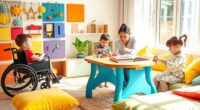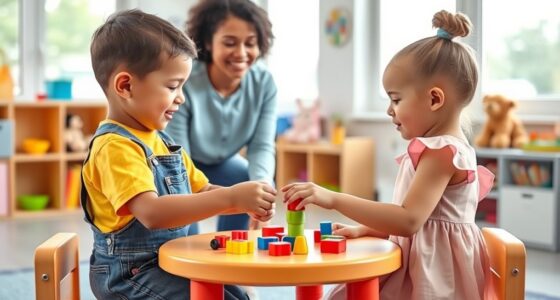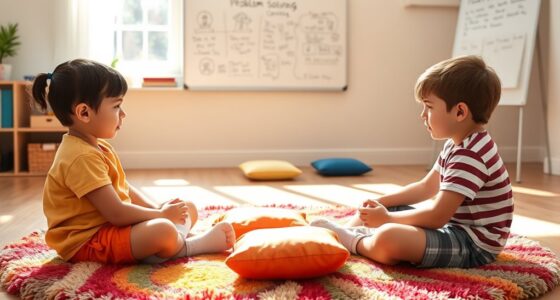To support neurodivergent kids in play settings, create inclusive environments that address sensory needs and promote positive peer interactions. Reduce triggers like loud noises and bright lights, and include sensory-friendly features like calming textures and noise-canceling headphones. Facilitate structured activities and social cues to help children connect and feel comfortable. When you focus on blending sensory integration with opportunities for social engagement, you’ll foster confidence and joy in every child’s play experience—if you continue exploring, you’ll find helpful strategies to make it happen.
Key Takeaways
- Design inclusive play areas with sensory-friendly features and reduced overstimulating stimuli.
- Use sensory integration strategies, like calming textures and controlled sound levels, to support self-regulation.
- Encourage peer interactions through structured activities, social scripts, and visual cues to foster social skills.
- Arrange environment spaces to promote sharing, turn-taking, and cooperative play for all children.
- Combine sensory and social approaches to create supportive environments that boost confidence and independence.

Creating inclusive play environments is essential for supporting neurodivergent kids, who often experience social and sensory challenges that can make traditional play settings overwhelming or inaccessible. When designing these spaces, you need to focus on sensory integration—creating environments that balance sensory input so children can feel safe and comfortable. For some neurodivergent kids, loud noises, bright lights, or crowded areas can trigger sensory overload, leading to anxiety or withdrawal. By incorporating sensory-friendly features like soft lighting, noise-canceling headphones, or calming textures, you help children regulate their sensory experiences, making play more enjoyable and less stressful. Offering varied sensory options, such as tactile mats or weighted blankets, allows kids to explore and self-regulate at their own pace, fostering a sense of control and comfort. Understanding sound design techniques can help you create environments with balanced auditory stimuli, reducing potential sensory overload and promoting calmness.
Creating sensory-friendly play spaces fosters comfort, safety, and enjoyment for neurodivergent children.
Peer interactions are also a crucial part of inclusive play. You want to encourage opportunities where neurodivergent children can connect with their peers in ways that feel safe and engaging for them. This might mean establishing structured activities that promote teamwork or providing social scripts that help children understand expected behaviors. Remember, social skills can be difficult for some neurodivergent kids, so creating environments that support positive peer interactions requires patience and intentional planning. Use visual cues or social stories to prepare children for group play, reducing uncertainty and anxiety. When peers are included in your approach, it fosters empathy and understanding, which can help neurodivergent kids feel more accepted and less isolated.
You should also consider how your environment facilitates peer interactions—arranging the space to encourage sharing, turn-taking, and cooperative play. Providing accessible toys and materials that all children can use together helps break down social barriers. For example, offering sensory bins or collaborative art projects creates natural opportunities for children to engage with each other without pressure. As you observe interactions, gently guide children to include others and celebrate their efforts, promoting a sense of belonging. Remember, neurodivergent kids may need additional support to initiate or sustain interactions, so be ready to step in with gentle prompts or cues to help them navigate social situations confidently.
Ultimately, supporting neurodivergent kids in play settings means thoughtfully blending sensory integration strategies with opportunities for meaningful peer interactions. When you create spaces that respect sensory needs and foster social connections, you’re helping children develop confidence, independence, and a joyful attitude toward play. These environments not only accommodate their unique ways of experiencing the world but also empower them to thrive alongside their peers.
Frequently Asked Questions
How Can I Identify Specific Sensory Needs of a Neurodivergent Child?
To identify a neurodivergent child’s specific sensory needs, observe their behaviors and responses during play. Pay attention to their sensory profiles and note what seems to calm or overstimulate them. Notice sensory triggers like loud noises, bright lights, or tactile experiences that cause distress or comfort. By carefully observing and documenting these reactions, you can better understand their unique sensory preferences and tailor activities to support their comfort and engagement.
What Are Effective Ways to Communicate With Non-Verbal Neurodivergent Kids During Play?
You might think communication with non-verbal neurodivergent kids is impossible, but it’s surprisingly effective with visual cues and assistive technology. Use picture cards, gestures, or apps to help them express needs and feelings during play. Be patient, observe their responses, and adapt your approach. This intentional, tech-supported method turns silent moments into meaningful interactions, proving that words aren’t always necessary to connect and understand.
How Do I Handle Challenging Behaviors in Inclusive Play Environments?
When challenging behaviors occur, use calming strategies like deep breathing or sensory breaks to help the child regain composure. Incorporate social stories to prepare them for different situations, setting clear expectations. Stay patient, observe triggers, and gently redirect when needed. Consistent routines and positive reinforcement encourage better behavior. Remember, understanding and compassion are key in creating a supportive, inclusive play environment that helps neurodivergent kids feel safe and respected.
Are There Recommended Toys or Materials That Support Neurodivergent Children’s Engagement?
You should incorporate fidget toys and sensory bins into play settings to support neurodivergent children’s engagement. Fidget toys help children focus and calm, while sensory bins offer tactile exploration that can soothe and stimulate. By providing these materials, you create an inviting environment that caters to different sensory needs, encouraging participation and comfort. Always observe individual preferences to guarantee the toys and materials meet each child’s unique sensory profile.
How Can I Foster Peer Interactions Among Neurodivergent and Neurotypical Children?
Think of fostering peer interactions as planting seeds of connection. You can build friendships and encourage sharing interests by creating inclusive activities that appeal to all children. Facilitate guided play where neurodivergent and neurotypical kids collaborate, listen actively, and celebrate each other’s strengths. Reinforce positive interactions, use clear communication, and model kindness. This nurturing environment helps children see each other’s unique qualities and develop genuine bonds that grow stronger over time.
Conclusion
By embracing patience and understanding, you become the gentle gardener nurturing a diverse garden of young minds. Each child’s unique abilities blooms when given the right environment, like stars shining brighter in the night sky. Remember, your support is the steady hand guiding their growth, turning challenges into opportunities. Together, you create a vibrant tapestry of play, where every thread – no matter how different – adds to the beautiful masterpiece of their lives.










